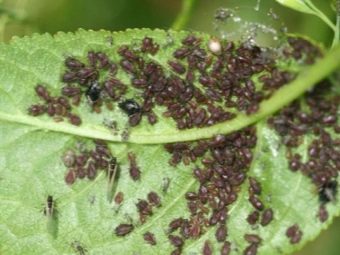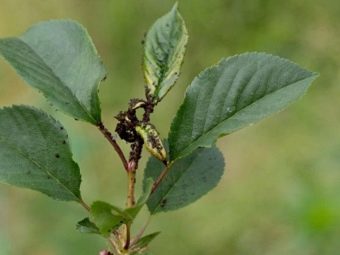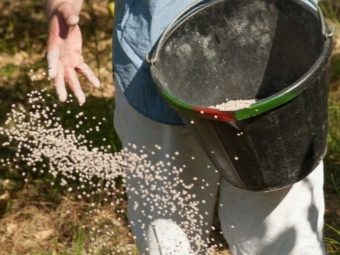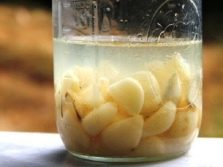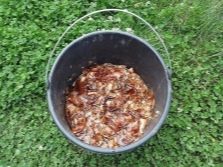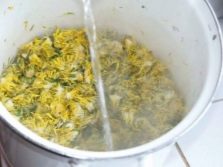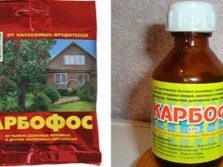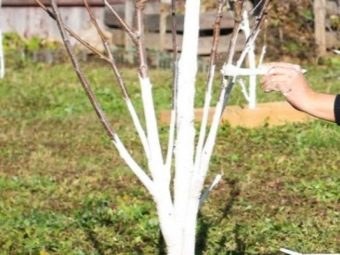How to get rid of aphids on cherries?
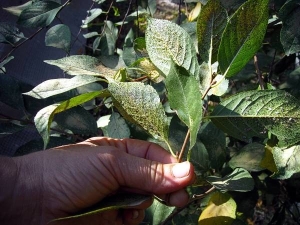
Summer residents, carefully caring for plantings, lose sight of clusters of aphids on leaves and shoots.At first, they do not see it because of the small focus of the lesion (the body of an insect is 5–7 mm in length), and then it is too late to take measures. Due to the rapid reproduction of aphid captures new nourishing healthy areas, sucking a small proboscis juices from them. Having settled with one fruit tree, she chooses a new site for herself. It is worth considering how to still deal with it.
Pest description
Aphid is an insidious pest that seems harmless at first sight. It belongs to the superfamily of insects from the order of hemiptera. Previously, they mistakenly attributed it to the squadron of the wings. Scientists have recognized about 4 thousand species of aphids, of which almost 1 thousand are found in Europe. Any aphid, including black feasts, vegetable juices. Unlike ordinary aphids, black eats leaves and shoots of cherry. It is a dangerous pest, contributing to the occurrence of its diseases, causing developmental abnormalities (galls, gall-like formations).
Signs of
While other voracious insect pests eat fruits, stems and leaves, leaving visible traces in their places, the aphid sucks the juice imperceptibly, choosing the back side of the leaf plate and the tops of young shoots. At first, the traces of its activity are invisible, and therefore gardeners do not sound the alarm. They start processing, noticing that the leaves of the cherry tree are twisted, and the trunk is covered with hordes of ants. Their sticky secret beckons — honeydew exuded by aphids.
Later in the sticky secretions develops black, and since the insect saliva contains dangerous microorganisms that quickly penetrate the cherry cells, picking up other diseases of the fungal type is inevitable. “Tidbits” for cherry aphids are the underside of leaves, growth points, young shoots, pedicels and buds. In places where the black aphid appears, life leaves a tree: because of it, the leaves will turn yellow on the cherry, they will stop developing or the buds will become ugly.
The reasons
There are several reasons for the defeat of cherry. Gardeners limit the care of her watering and fertilizer treatment. They forget to weed the tree trunk, and the weeds are the habitat of the aphids. Rapidly multiplying, it hits healthy areas on weeds, and then gets to the cherry. The juices that it leaves behind attract ants. They enter into symbiosis with it: with the onset of cold weather, they transfer the larvae deep into the soil, and with the onset of heat they carry it back to the lush weeds and fruit trees.
Agrotechnics do not lose sight of ants. The more of them, the more infected plants in the garden. Over the summer, the insect breeds up to twenty generations of offspring. To prevent this from happening, the trunk circle is kept “clean”. It is necessary to weed out weeds with roots and sow calendula or marigolds nearby.
Effects
Novice gardeners do not see in the pest a serious opponent, but in vain. Each case of acquiescence is unique, but often everything ends with the following consequences:
- the death of the cherry due to the mass distribution of the pest;
- the risk of catching up other, more dangerous and not treatable diseases;
- harvesting less than in previous years;
- the acquisition of the fruit of an ugly form;
- the fineness of the fruit;
- rapid infection of other shrubs and garden crops grown on the site.
Control measures
Faced with an insect only once, summer residents make every effort to get rid of it. The following comprehensive measures help to combat it:
- weeding weeding near the tree circle;
- the destruction of wild birds;
- the introduction of minerals to restore the immunity of the cherry;
- attraction to the site of beneficial insects that feed on aphids;
- struggle with folk remedies;
- introduction of chemicals, if the lesion is large.
Physical
Noticing the small foci of black cherry lice, agrotechnicians advise to start with alternative methods.At the initial stage help belt traps. They are used for wrapping the trunk of a fruit tree. In specialized stores sell special "trap gels." But for all their efficiency, they are expensive, quickly consumed and dry in the summer heat.
Experienced gardeners make homemade belt-traps. They take pieces of cotton material or wallpaper, cut them into strips 10–15 centimeters wide. They wrapped the trunk, fixing the twine for strength. On top of them paste a tape from flies in a spiral. Due to the loss of efficiency, homemade trap belts change 2-3 times per season. Ants stick to the tape tightly. The threat of spreading honeydew, which is left behind by aphids, is over.
Summer residents are fighting with ants. They are looking for an anthill and destroy it, pouring boiling water from top to bottom. This helps to kill the ants and larvae of aphids that they transferred to the ant nest. Before its destruction and fastening of the trap belts to the cherry trunk, the tree trunk circle is weeded.
Weeding eliminate the pest's escape route at the end of treatment.
Biological
In the fight against cherry aphids, experienced gardeners do not immediately engage "heavy artillery." First, they plant basil, dill, marigold, cilantro, millennial, horseradish and other odorous crops near cherries. They build houses for birds and secure them securely among the branches of the cherry. They attract to the site by sowing marigolds, cornflowers, dill ladybirds, which do not resist the temptation and necessarily eat insects. Effective washing the barrel with a strong jet of water.
Folk
Without noticing black aphids in time, biological and physical methods will not help. Cherry will wither. Agrotechnics recommend cultivation with folk remedies: soap solution, ash-based products, herbal extracts of medicinal action, onion-garlic-based mixtures. They do it until the kidneys open. It is worth considering the most effective folk methods.
- Infusion of garlic. 0.1 kg of garlic is crushed, put in a 10-liter bucket and poured water to the brim. Having given it for 2 days, the product is poured into a spray bottle and distributed over the surface of branches.
- Infusion of onion peels. For 10 liters of water you will need a pound of onion peel. After 48 hours, they process the cherry, overflowing the infusion after filtering into a spray bottle. After 2 weeks fix the result of re-processing.
- Infusion of elecampane. Water is poured into a 10-liter container, before pouring into it 1.5 thousand grams of dried or 3-4 kilograms of fresh elecampane. After infusion for two days, the infusion is filtered and sprayed over the entire surface of the cherry with a broom.
- Dandelion infusion. 0.3 kg of the torn off leaves of a dandelion is crushed, put into a container and poured 10 liters of warm and warmed to 40 degrees water. After insisting for two days and straining the insect is destroyed.
- Ash solution. They take three hundred grams of ash and carefully sift, passing through a sieve. It is poured into a saucepan, poured water, put on the fire and boil for thirty minutes. The solution is brought to a suitable treatment, topping up with water to 10 liters. The wood is sprayed with this solution every ten days.
- Infusion of tobacco. Tobacco steamed in the water during the day. Then dilute it with water in the ratio of one to three and treat them with cherry.
- Soap solution. A piece of laundry soap is ground on a grater, dissolved in 10 liters of warm liquid and sprayed with the resulting solution of wood.
The means listed above are valid, but not for long - before the first rain or abundant watering. Because of this treatment, soap or tobacco solution is made every 2 weeks.
Chemical
Not all gardeners use products prepared by themselves. They buy special drugs, which are divided into several groups.
- Contact. They quickly give results, as they are absorbed into the body of a small bug. It dies, and those individuals that remain, breed offspring and re-inflict damage to the tree.By means of this action include "Fufan", "Arrivo", "Karbofos."
- Intestinal. They are distinguished by their great effectiveness, since they enter the body along with nutritious plant juices. These include "BI-58 New" and "Confidor". Exodus one - the death of the pest.
- System. Their validity is up to 15 days. They act, even if the summer resident watered a tree or heavy rain. They are absorbed into the cells of the plant gradually, turning the juice into poison. Aphids feed on them and die. A vivid example is Aktara.
Not all gardeners are willing to use the drugs listed above, noticing a pest. They are frightened by the possibility of poisoning, since during processing it can get on other garden crops, and they can eat them. Their fears are not groundless. It is impossible to carry out processing when the cherry blossoms and the ovary appears on it. Otherwise there is a risk of poisoning the fruit of the tree when they ripen.
"Fitoverm"
"Fitoverm" is a biological type insecticide that eliminates aphids from the first treatment. To achieve such a result, spend it in the early morning or evening. Choose a fine, windless day. If it rains in a few hours, the procedure is repeated. For processing take 4 ml of the drug "Fitverm" and 2 liters of water. After thorough mixing, pour the solution into the spray gun and treat the lower part of the plant with it, directing the stream from the bottom up, otherwise the treatment will not bring the desired result.
Agrotechnics advise using "Fitoverm" no more than four times per season after 7–20 days.
Aktara
If in early spring, before the appearance of buds or after flowering, an abundance of lesions of aphids on cherries is noticed, it is necessary to treat it with Aktara. He acts fast. Two grams of the product diluted in a liter of water, mix thoroughly, and then add another 9 liters of water.
Due to the fact that the tool is toxic, use it carefully. Wear rubber gloves, a respirator and carefully hide the exposed skin behind clothing. Aktara remains in effect for twenty days. Exactly so much must pass from the moment of the last disinfection to the gathering of fruits, otherwise berry poisoning is possible.
"Confidor"
Experiments show that the drug "Confidor" effectively defeats aphids. He kills her, simultaneously stimulating the leaves to grow. It is used in the southern regions of the Russian Federation without fear, knowing that it acts under the influence of high temperatures. The frequency of processing - 1-2 times per season. When preparing, dissolve in 10 liters of liquid 2 grams of product. If the lesion is large, 4 g of the drug is dissolved in the same amount of water.
Divorced "Confidor" do not store more than a day. If necessary, mix it with liquid soap, which guarantees the best adherence of the product to the sheet plate.
The aphids are beaten by insecticides - Iskra, Inta-vir, Karate, divorced according to instructions.
Correct processing
When disinfecting wood, observe the following precautions:
- chemicals contribute in the spring after the appearance of the leaves on the fruit tree;
- decoctions and fruit infusions are processed until August; they do not harm beneficial insects, pets and humans;
- the tree is treated in the early morning before sunset, otherwise the young leaves on the cherry tree will burn during processing;
- hands and face protect against the action of the drug, wearing gloves and a mask; open areas on the body do not leave;
- when the chemical agent gets on the skin and mucous membranes, wash them with cool tap water;
- the treatment is carried out strictly according to the instructions and do not use the drug expired.
Prevention
Fighting a pest is harder than protecting a fruit tree from it. In the offseason, trunks of cherries and trees near it are whitewashed; dead bark is removed to a healthy place. This treatment is an obstacle to the breeding of aphids. On the backyard plot attracts the ladybird by planting nearby spicy herbs that repel the hordes of aphids. Anthill destroy, filling the courses with boiling water.
In order to prevent the ants crawling on cherries behind the sticky secretion of aphids, they fix the “trapping belts” on its trunk.
Learn how to deal with aphids in the next video.


